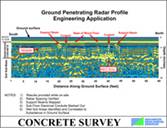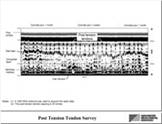
|
Sample GPR Profile Showing Detected Rebar and Other Subsurface Features (Click Image to Enlarge) |

Applications: |
|
During construction, repair, and modification of concrete structures there is commonly a need to evaluate, verify and locate specific features inside the concrete slab. AGS specializes in providing non-destructive concrete evaluation and imaging services utilizing highly experienced geophysicists and the latest Ground Penetrating · Examine the structural integrity of roads, bridges and buildings · Verify construction specifications · Locate and map re-bar · Locate and map pre-stressed members · Determine slab thicknesses when only one side of structure can be accessed · Clear boring locations · Identify voids and honeycombs in walls and slabs · Determine success of void grouting · Map utility chases in building walls · Identify penetrative cracks |
|
Post Tension Tendon Survey (Click Image to Enlarge) |
|
Concrete Services |


|
Advanced Geological Services |
|
Providing Comprehensive Geophysical Solutions |
Information: |
|
Since its inception, AGS has specialized in non-destructive testing of concrete structures. AGS maintains both 1 GigaHertz (GHz) and 1.5 GHz antennas to provide finely detailed images of subsurface features. The real-time results provided by GPR methods are ideal for rapid turn-around and flexibility required during concrete coring operations. Experienced post-graduate level geophysicists are provided on-site for data acquisition and interpretation to ensure accurate and insightful analysis and interpretation of GPR responses. In addition to performing a real-time mark out of rebar, tension cables, and conduits during active construction, AGS can provide overlays to existing AutoCAD plot plans identifying and documenting additional object locations and depths. |
Advantages: |
|
GPR signals do not penetrate metal, therefore access to the opposite side of a wall or floor (i.e. lower level ceiling) may be required to identify features beneath or behind metal sheeting or a closely spaced metal mesh. Access to both sides of a wall or floor may also be required when there is an upper and lower level of re-bar. |
Limitations: |
|
Concrete evaluation using GPR methods provides data acquisition flexibility, high-resolution visual data and realtime results. Data can be collected allowing minimal disruption of normal site activities, in locations such as active and/or operating hospitals, universities, shopping malls or office buildings. In addition, unlike conventional ultrasound and x-ray methods, data collection only requires access to one side of the concrete slab or wall to be imaged. |